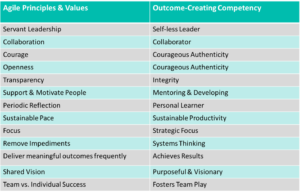Agile Leadership and Outcome-Creating Competencies
Written by: Michele Madore & Michael Spayd
How do we recognize Agile Leadership? Throughout the history of Agile as a methodology, a philosophy and a cultural meme, it has been challenging to tie Agile values, principles and practices to exactly what is required in an Agile Leader. We could say the definition of an “Agile Manager” has been in short supply. Then, as we moved into the age of Agile Transformations, a further question arises: What are the characteristics of a successful Agile Transformational Leader? We know it requires leadership that takes personal responsibility for the outcomes that matter most. For the two of us looking through the lens of 25 years in transformations, when we combine the two questions, we get one answer: leadership development.
We have found the Leadership Circle Profile — and the underlying Universal Model of Leadership (Mastering Leadership, Anderson & Adams, 2016) — to offer a scientifically-driven and actionably-specific way of measuring — and enacting — Agile leadership. And that to truly develop Transformational Leaders, the Outcome-Creating (Creative) competencies are exactly where we need to focus; this is why we bring in the Leadership Circle’s developmental model and Leadership System as a foundation to our Agile Transformation work.
So, let’s explore how the Agile values we look for in leaders correlate to the Creative Competencies.
The Correlation between Outcome-Creating Competencies & Agile Principles
To help see the correlation, we first define The Leadership Circles five Summary Dimensions, then list the Creative Competencies that comprise each, and finally how various Agile principles (e.g., Agile principles, values, notions, ideals, etc.) are enabled in a leader’s behavior and thinking by specific Creative Competencies.
The five Summary Dimensions are Relating, Self-Awareness, Authenticity, Systems Awareness and Achieving.
I. Relating – measures the leader’s capability to relate to others in a way that brings out the best in people, groups, and organizations. It is composed of: Caring Connection, Fosters Team Play, Collaborator, Mentoring & Developing, and Interpersonal Intelligence.
How Relating Maps to Agile – The first Agile Value “Individuals and interactions over processes and tools” places the emphasis on teamwork and communication. Since it is teams of individuals that build products, they need to work together productively and effectively. In Agile, we value teams over individuals, so there is a need for people to develop the competencies that enable them to take other’s perspectives and have greater Interpersonal Intelligence. We spend a lot of time on Fostering Team Play and creating healthy teams, by creating more Caring Connection in relationships, because we understand the need for individuals, teams, and leaders to reach across the organization to collaborate with one another. The third Agile Value “Customer Collaboration over Contract Negotiation,” ties directly with the need for leaders to develop the “Collaborator” competency. Agile does away with command and control leadership, requiring a fundamental shift in mindset and the belief structure that makes leaders feel safe when they are in control which in turn enables them to Mentor & Develop others. In other words, to move away from traditional “Command and Control” management, a person has to deal with their own internal limitations that are limiting their ability to “let go” of their perceived need to drive others in order to get things done.
II. Self-Awareness – measures the leader’s orientation to ongoing professional and personal development, as well as the degree to which inner self-awareness is expressed through high integrityleadership. It is composed of: Selfless Leader, Balance, Composure and Personal Learner.
How Self-Awareness Maps to Agile – Because Agile is a highly relational way of working — and especially in a transformational context — we need to understand that we ourselves are the primary instrument of change. This requires that we not be ‘run’ by our emotions (Composure, Balance); we are able to work for the benefit of all, maintaining our primary focus not on the self but on others — our team, customers, the environment (Selfless Leader); and our ability to learn from our (and others) mistakes (Personal Learner).
The Agile ideal of servant leadership bears further exploration. As Robert Greenleaf said, servant leaders “put the needs of a group over their own…foster trust…by holding themselves accountable, help others develop, show appreciation, share power and listen without judging.” This ‘other-oriented’ leadership requires significant development in the leader, as measured by the Selfless Leader dimension: “the extent to which the leader pursues service over self-interest, where the need for credit and personal ambition is far less important than creating results.” Periodic reflection (Agile Principle #12) and continuous improvement show up in the practices of Retrospectives and Lean Kaizen events. Both draw on Personal Learner: the ability to “actively and reflectively pursue growth in self-awareness, wisdom, knowledge and insight.” Without a high degree of self-awareness, the Agile leader will not be fully aware of their impact in skillfully navigating the organization through change. For real transformational change to be successful, the organization needs to be fully enrolled and feel compelled to want to go through the change. This takes leadership that is completely aware of the fact that they are an instrument of change, and they have to model the change they want to see.
III. Authenticity – measures the leader’s ability to relate to others in an authentic, courageous, and high-integrity manner. It is composed of Integrity & Courageous Authenticity.
How Authenticity Maps to Agile – We could say that Agile is shot through with Authenticity. Agile maintains a strong ethic to talk in a courageous way, speaking truth to power (Courageous Authenticity), not agree with proposals (or estimates) we don’t truly believe in (Integrity), and generally acting from our authentic self. Agile wants us to transcend our professional mask — to honestly choose the work we want (sign-up for stories vs. having them assigned to us); challenge status quo thinking rather than pleasing the boss, and sharing unpopular views in group discussions rather than going along with the herd. The Agile value of transparency is generally about factual things — like where the real status of the project is rather than a ‘doctored’ version that protects political sensibilities. In more personal terms, transparency includes the honest feelings of the heart, expressed at all levels in the organization. We are thus able to share our more vulnerable feelings — like admitting we don’t know how to do something, being willing to engage in a challenging conflict with a colleague, or being honest when we feel our boss just doesn’t listen. A leader strong in Authenticity will be experienced by others as an Agile Leader. Remaining in a Problem-Reacting stance will create an emotional cost that the lack of transparency and authenticity generate.
IV. Systems Awareness – measures the degree to which the leader’s awareness is focused on whole system improvement, productivity, and community welfare. It is composed of: Community Concern, Sustainable Productivity, and Systems Thinker.
How Systems Awareness Maps to Agile – Agile is a sense and respond way of working in Complex Adaptive Systems thinking, which enables organizational agility, including whole systems improvement, productivity, and community welfare. At the very center of Agile is a focus on continuous improvement through reflecting and adapting early and often. A core Agile practice is removing obstacles — the things that are impeding progress — both at the team and the organizational level. When team members raise impediments, rather than seeing it as a singular event, it is critical to think more systemically (Systems Thinker) in order to get to the root cause, and ultimately the mental models that drive the behavior. When more senior leaders take responsibility for organizational impediments it is an expression of Community Concern, since the implications stretch far beyond individual teams. Agile Principle #8 promotes sustainable development and the belief in maintaining a consistent and sustainable pace indefinitely. The competence of Sustainable Productivity, as well as Community Concern, enables this perspective and behavior in a leader. Staying in Problem-Reacting mode will generate “fire-fighting” responses to impediments and sub-optimized organizational results.
V. Achieving – measures the extent to which the leader offers visionary, authentic and high achievement leadership. It is composed of: Strategic Focus, Purposeful & Visionary, Achieves Results, and Decisiveness.
How Achieving Maps to Agile – The very first Agile principle says “Our highest priority is to satisfy the customer through early and continuous delivery of valuable software”. The 7th Principle says that “Working software is the primary measure of progress”. These are both grounded in Achieves Results, since customers pay for — and value — software, not documentation or reports about that software. The way in which we deliver that software is through the Vision of the business, or the “Product Owner” in Agile terms. A Product Vision is essential for teams to be able to self-organize and understand the direction in which they are going (Purposeful & Visionary). Much emphasis is placed on the Product Owner’s ability to make clear, timely decisions (Decisiveness) and to stay focused on the strategy (Strategic Focus) and vision for that Product. Leaders who are in a problem-reacting stance will need to develop these outcome-creating competencies in order to move from a place of status-quo where they are habitually reacting to the latest crisis, conflict or challenge, pulling them away from their purpose and vision.

When we first engaged in the exercise of mapping Agile principles and values to the Outcome-Creating competencies, we intuited there would be a high overlap. When we had finished the mapping — and as we started writing this post — we were struck hard by an insight: it literally does not seem possible for a leader to evidence Agile Leadership without their having developed the Outcome Creating competencies in themselves. This was a stronger argument than we were prepared to make going in, but the evidence seems overwhelming. It reinforced our appreciation for The Leadership Circle tool and way of thinking.
Michele Madore and Michael Spayd co-founded Trans4mation, Organizational Transformation consultancy in the Agile space.
Trans4mation believes that growing deep, sustainable organizational agility must start with senior leaders. Their work is informed by a comprehensive integral framework. They are guided by a methodology that embodies a deep understanding of the nature of organizational change.







